How Metal Detection Equipment Helps Ensure Safer Packaged Foods

The food industry is under increasing pressure to meet stringent safety standards, ensuring consumers receive high-quality products free from contaminants. Among the various measures implemented to meet these standards, metal detection equipment is critical in safeguarding packaged foods.
Contaminants such as metal fragments can enter food products during processing and packaging, potentially leading to health hazards, product recalls, and loss of consumer trust. By incorporating advanced technology, businesses can protect their brands and meet regulatory requirements.
Read on to learn how metal detection equipment can help ensure safer packaged foods.
The Need for Metal Detection in Packaged Foods
Contaminants in packaged foods pose a serious risk to public health and can lead to financial repercussions for manufacturers. Metals, one of the most common contaminants, may enter food through various sources, such as the following:
- Processing equipment wear and tear
- Fragmentation of tools during production
- Accidental introduction during packaging
Even small fragments of metal can also cause injuries, such as choking or lacerations, and lead to legal liabilities for companies. As a result, regulatory authorities enforce strict guidelines to ensure food products are free from foreign objects. As such, metal detection systems are indispensable tools for meeting these standards.
Moreover, using reliable solutions like TDI Packsys offers food manufacturers access to conveyorized metal detectors that efficiently identify and eliminate risks before products reach the consumer.
How Metal Detection Equipment Works
Modern metal detectors utilize advanced electromagnetic fields to identify foreign metal objects in packaged foods. These systems typically operate in three main stages, such as the following:
- Detection: Electromagnetic sensors scan the product for any metallic interference.
- Identification: The system determines the size, type, and location of the contaminant.
- Elimination: If a contaminant is detected, the product is rejected through automated mechanisms, such as pneumatic pushers or diverters.
These stages ensure that only contaminant-free products move forward in the supply chain to ensure safety.
Benefits of Metal Detection Equipment in Food Safety
Metal detection equipment is essential for food safety, ensuring packaged products are free from harmful metal contaminants. Below are the key benefits of metal detection equipment in food safety:
Enhanced Consumer Protection
Metal detection systems can protect consumers from potential injuries caused by ingesting metal fragments. Ensuring food safety can also build trust and reinforce brand reputation, which is essential in today’s competitive market.
Compliance with Regulatory Standards
Governments and international bodies impose strict safety standards on food manufacturers. By adopting metal detection systems, businesses can help meet these regulations to avoid penalties or recalls.
Reduced Waste and Costs
Detecting contaminants early in the production process can minimize waste by preventing contaminated products from reaching later packaging stages. This efficiency can reduce costs associated with recalls and legal disputes.
Improved Operational Efficiency
Advanced metal detection systems integrate seamlessly into production lines. Automated rejection mechanisms can streamline operations by reducing manual inspections and downtime.
Types of Metal Detection Equipment for Packaged Foods
Metal detection equipment comes in various types, tailored to meet the diverse needs of packaged food production. These types include:
Conveyorized Systems
Conveyorized metal detectors are ideal for high-volume production lines. They allow for continuous inspection of packaged goods, ensuring that contaminants are identified and removed without interrupting operations.
Pipeline Metal Detectors
These systems are designed for inspecting liquid or semi-liquid products, such as sauces and soups, as they flow through pipelines.
Gravity Feed Detectors
Gravity-fed systems are suitable for inspecting powdered or granular products, ensuring contaminants are removed before packaging.
Compact Systems
Smaller metal detectors are available for manufacturers with limited space or specific production needs, ensuring even smaller facilities can maintain high safety standards.
Applications Across the Food Industry
Metal detection systems are versatile and can be applied in various sectors of the food industry, including:
- Bakery Products: The systems ensure that baked goods are free from metal shavings caused by mixers or slicers.
- Dairy Products: The systems detect contaminants in packaged cheeses, yogurts, and milk products.
- Meat and Seafood: The systems identify metal fragments in processed meats, poultry, and fish.
- Snack Foods: The systems monitor chips, candies, and other snacks for contaminants during packaging.
With these applications in mind, businesses can get the most out of metal detection equipment for their daily operations.
The Role of Metal Detection in Preventing Recalls
Food recalls are costly and damaging to a brand’s reputation. A single recall can result in millions of dollars in lost revenue, not to mention the negative impact on consumer confidence. As such, metal detection systems act as a safeguard, preventing contaminated products from leaving the facility and reaching consumers.
Innovations in Metal Detection Technology
The food industry continues to benefit from advancements in metal detection technology. Today’s systems are equipped with features such as:
- Multifrequency Scanning: This can improve detection accuracy across various products.
- Touchscreen Interfaces: This can simplify operation and data tracking for quality control.
- Hygienic Design: This can ensure compliance with food safety and sanitation standards.
By staying ahead of these technological developments, businesses can enhance safety and operational efficiency.
Conclusion
Metal detection equipment is a cornerstone of food safety in the packaged goods industry. By keeping the information presented above in mind, manufacturers can effectively protect consumers, comply with regulations, and minimize financial risks. As the industry evolves, embracing innovative solutions will remain essential to maintaining a safe and reliable food supply chain.






